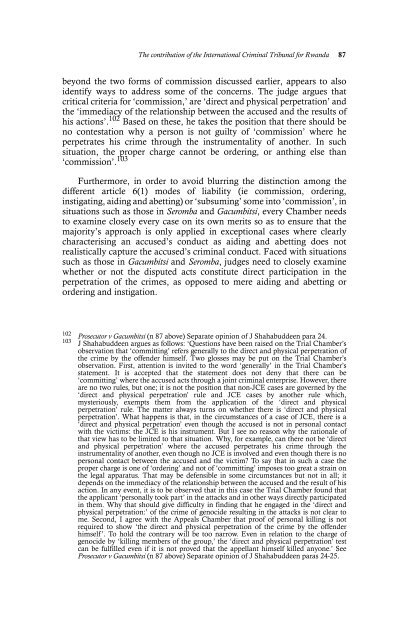Prosecuting International Crimes in Africa - PULP - University of ...
Prosecuting International Crimes in Africa - PULP - University of ...
Prosecuting International Crimes in Africa - PULP - University of ...
Create successful ePaper yourself
Turn your PDF publications into a flip-book with our unique Google optimized e-Paper software.
The contribution <strong>of</strong> the <strong>International</strong> Crim<strong>in</strong>al Tribunal for Rwanda 87<br />
beyond the two forms <strong>of</strong> commission discussed earlier, appears to also<br />
identify ways to address some <strong>of</strong> the concerns. The judge argues that<br />
critical criteria for ‘commission,’ are ‘direct and physical perpetration’ and<br />
the ‘immediacy <strong>of</strong> the relationship between the accused and the results <strong>of</strong><br />
his actions’. 102 Based on these, he takes the position that there should be<br />
no contestation why a person is not guilty <strong>of</strong> ‘commission’ where he<br />
perpetrates his crime through the <strong>in</strong>strumentality <strong>of</strong> another. In such<br />
situation, the proper charge cannot be order<strong>in</strong>g, or anth<strong>in</strong>g else than<br />
‘commission’. 103<br />
Furthermore, <strong>in</strong> order to avoid blurr<strong>in</strong>g the dist<strong>in</strong>ction among the<br />
different article 6(1) modes <strong>of</strong> liability (ie commission, order<strong>in</strong>g,<br />
<strong>in</strong>stigat<strong>in</strong>g, aid<strong>in</strong>g and abett<strong>in</strong>g) or ‘subsum<strong>in</strong>g’ some <strong>in</strong>to ‘commission’, <strong>in</strong><br />
situations such as those <strong>in</strong> Seromba and Gacumbitsi, every Chamber needs<br />
to exam<strong>in</strong>e closely every case on its own merits so as to ensure that the<br />
majority’s approach is only applied <strong>in</strong> exceptional cases where clearly<br />
characteris<strong>in</strong>g an accused’s conduct as aid<strong>in</strong>g and abett<strong>in</strong>g does not<br />
realistically capture the accused’s crim<strong>in</strong>al conduct. Faced with situations<br />
such as those <strong>in</strong> Gacumbitsi and Seromba, judges need to closely exam<strong>in</strong>e<br />
whether or not the disputed acts constitute direct participation <strong>in</strong> the<br />
perpetration <strong>of</strong> the crimes, as opposed to mere aid<strong>in</strong>g and abett<strong>in</strong>g or<br />
order<strong>in</strong>g and <strong>in</strong>stigation.<br />
102 Prosecutor v Gacumbitsi (n 87 above) Separate op<strong>in</strong>ion <strong>of</strong> J Shahabuddeen para 24.<br />
103 J Shahabuddeen argues as follows: ‘Questions have been raised on the Trial Chamber’s<br />
observation that ‘committ<strong>in</strong>g’ refers generally to the direct and physical perpetration <strong>of</strong><br />
the crime by the <strong>of</strong>fender himself. Two glosses may be put on the Trial Chamber’s<br />
observation. First, attention is <strong>in</strong>vited to the word ‘generally’ <strong>in</strong> the Trial Chamber’s<br />
statement. It is accepted that the statement does not deny that there can be<br />
‘committ<strong>in</strong>g’ where the accused acts through a jo<strong>in</strong>t crim<strong>in</strong>al enterprise. However, there<br />
are no two rules, but one; it is not the position that non-JCE cases are governed by the<br />
‘direct and physical perpetration’ rule and JCE cases by another rule which,<br />
mysteriously, exempts them from the application <strong>of</strong> the ‘direct and physical<br />
perpetration’ rule. The matter always turns on whether there is ‘direct and physical<br />
perpetration’. What happens is that, <strong>in</strong> the circumstances <strong>of</strong> a case <strong>of</strong> JCE, there is a<br />
‘direct and physical perpetration’ even though the accused is not <strong>in</strong> personal contact<br />
with the victims: the JCE is his <strong>in</strong>strument. But I see no reason why the rationale <strong>of</strong><br />
that view has to be limited to that situation. Why, for example, can there not be ‘direct<br />
and physical perpetration’ where the accused perpetrates his crime through the<br />
<strong>in</strong>strumentality <strong>of</strong> another, even though no JCE is <strong>in</strong>volved and even though there is no<br />
personal contact between the accused and the victim? To say that <strong>in</strong> such a case the<br />
proper charge is one <strong>of</strong> ‘order<strong>in</strong>g’ and not <strong>of</strong> ‘committ<strong>in</strong>g’ imposes too great a stra<strong>in</strong> on<br />
the legal apparatus. That may be defensible <strong>in</strong> some circumstances but not <strong>in</strong> all; it<br />
depends on the immediacy <strong>of</strong> the relationship between the accused and the result <strong>of</strong> his<br />
action. In any event, it is to be observed that <strong>in</strong> this case the Trial Chamber found that<br />
the applicant ‘personally took part’ <strong>in</strong> the attacks and <strong>in</strong> other ways directly participated<br />
<strong>in</strong> them. Why that should give difficulty <strong>in</strong> f<strong>in</strong>d<strong>in</strong>g that he engaged <strong>in</strong> the ‘direct and<br />
physical perpetration:’ <strong>of</strong> the crime <strong>of</strong> genocide result<strong>in</strong>g <strong>in</strong> the attacks is not clear to<br />
me. Second, I agree with the Appeals Chamber that pro<strong>of</strong> <strong>of</strong> personal kill<strong>in</strong>g is not<br />
required to show ‘the direct and physical perpetration <strong>of</strong> the crime by the <strong>of</strong>fender<br />
himself’. To hold the contrary will be too narrow. Even <strong>in</strong> relation to the charge <strong>of</strong><br />
genocide by ‘kill<strong>in</strong>g members <strong>of</strong> the group,’ the ‘direct and physical perpetration’ test<br />
can be fulfilled even if it is not proved that the appellant himself killed anyone.’ See<br />
Prosecutor v Gacumbitsi (n 87 above) Separate op<strong>in</strong>ion <strong>of</strong> J Shahabuddeen paras 24-25.

















